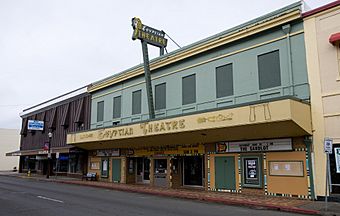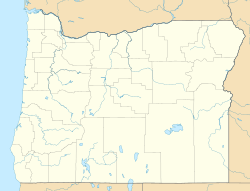Egyptian Theatre (Coos Bay, Oregon) facts for kids
Quick facts for kids |
|
|
Egyptian Theatre
|
|
 |
|
| Location | 229 S. Broadway, Coos Bay, Oregon |
|---|---|
| Area | less than 1 acre (0.40 ha) |
| NRHP reference No. | 10000281 |
| Added to NRHP | May 24, 2010 |
The Egyptian Theatre is a very old and special movie theater. You can find it in Coos Bay, Oregon, in the United States. It is known for its unique design, which looks like ancient Egyptian buildings.
Contents
History of the Egyptian Theatre
How the Theatre Was Built
A man named Charles Noble built the Egyptian Theatre. His family was one of the first to live in the area. He started building it in 1922. By 1925, he had spent a lot of money, about $200,000, to turn an old garage into this amazing theater.
Two architects, Lee Arden Thomas and Albert Mercier, designed the building. They added many cool Egyptian-style details. For example, there are pillars decorated with papyrus flowers. The ceiling lights are made of wrought-iron and look like cobra snakes. The stairways even have tall statues of pharaohs, which are ancient Egyptian kings.
Design and Features
The main part of the theater can seat 770 people. It is a great example of the Egyptian Theatre style. This type of Egyptian Revival architecture was very popular in the early 1900s in the U.S. People loved this style, especially after the discovery of King Tut's tomb in 1922.
The theater also has all its original backdrops from vaudeville shows. Vaudeville was a type of entertainment with different acts, like singing, dancing, and comedy. The theater first had only one screen. But in 1976, the balcony area was changed to hold two more screens. This made the total seating capacity 1,000 people.
Special Organ and Recognition
In the year 2000, the Egyptian Theatre had something very special. It was home to the only theatre organ in Oregon that was still in its original theater. This organ is a huge pipe organ called a 4/18 Mighty Wurlitzer. It makes amazing music and sound effects.
By 2010, the Egyptian Theatre was one of only four theaters left in the United States with this unique Egyptian Revival style. The theater started inviting the community to use it for different events. People could hold meetings, concerts, plays, and other gatherings there.
On May 24, 2010, the building was added to the U.S. National Register of Historic Places. This list includes important places that are worth saving because of their history. In 2011, the theater needed a lot of repairs, about $3 million worth. Because of this, the Historic Preservation League of Oregon put it on their list of "Most Endangered Places in Oregon." This list helps bring attention to historic places that need help to be saved.
See also



